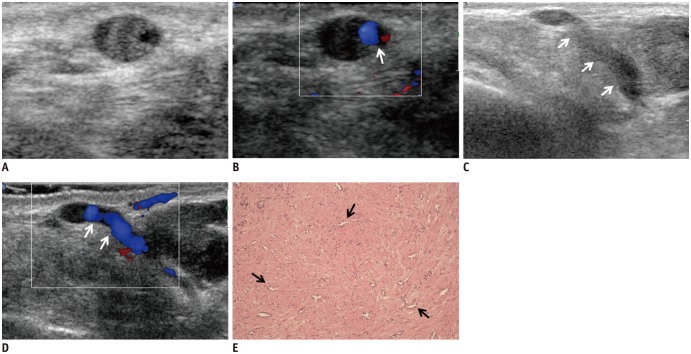Korean J Radiol.
2018 Aug;19(4):752-757. 10.3348/kjr.2018.19.4.752.
Ultrasonographic Findings of Subcutaneous Angioleiomyomas in the Extremities Based on Pathologic Subtypes
- Affiliations
-
- 1Department of Radiology, College of Medicine, Inje University Busan Paik Hospital, Busan 47392, Korea. sunjulee98@naver.com
- 2Department of Radiology, College of Medicine, Soonchunhyang University Bucheon Hospital, Bucheon 14584, Korea.
- 3Department of Radiology, Sungkyunkwan University School of Medicine, Kangbuk Samsung Hospital, Seoul 03181, Korea.
- 4Department of Radiology, Dongcheon Dongkang Hospital, Ulsan 44495, Korea.
- 5Department of Radiology, Daegu Fatima Hospital, Daegu 41199, Korea.
- 6Department of Pathology, College of Medicine, Inje University Busan Paik Hospital, Busan 47392, Korea.
- KMID: 2413704
- DOI: http://doi.org/10.3348/kjr.2018.19.4.752
Abstract
OBJECTIVE
The purpose of this study was to describe the ultrasonographic findings of angioleiomyoma based on pathological subtypes.
MATERIALS AND METHODS
Thirty-nine patients with subcutaneous angioleiomyomas in the extremities were retrospectively reviewed by two radiologists and a pathologist. Sonographic images were analyzed to evaluate each tumor's anatomic location, size, shape, margin, heterogeneity, echogenicity, associated findings, and vascularity.
RESULTS
Angioleiomyomas were divided into 3 subtypes: capillary (n = 16), venous (n = 22), and cavernous (n = 1). The one cavernous angioleiomyoma was a hypoechoic mass with rich vascularity. Hypoechogenicity was more frequently observed for venous tumors (77.3%) than for capillary tumors (43.8%), and isoechogenicity was more frequently observed for capillary tumors (56.2%) than for venous tumors (22.7%). Moderate vascularity was more frequently observed for venous tumors (59.1%) than for capillary tumors (12.5%), and little vascularity was more frequently observed for capillary tumors (62.5%) than for venous tumors (13.6%). The aforementioned findings including echogenicity (p = 0.034) and vascularity (p = 0.003) were statistically significant.
CONCLUSION
Awareness of sonographic findings of angioleiomyomas based on pathologic subtypes could be helpful for diagnosing angioleiomyoma and could increase diagnostic accuracy for superficial soft-tissue masses in our practice.
MeSH Terms
Figure
Reference
-
1. Jin W, Kim GY, Park SY, Chun YS, Nam DH, Park JS, et al. The spectrum of vascularized superficial soft-tissue tumors on sonography with a histopathologic correlation: Part 1, benign tumors. AJR Am J Roentgenol. 2010; 195:439–445. PMID: 20651202.
Article2. Gupte C, Butt SH, Tirabosco R, Saifuddin A. Angioleiomyoma: magnetic resonance imaging features in ten cases. Skeletal Radiol. 2008; 37:1003–1009. PMID: 18581112.
Article3. Park HJ, Kim SS, Lee SY, Choi YJ, Chung EC, Rho MH. Sonographic appearances of soft tissue angioleiomyomas: differences from other circumscribed soft tissue hypervascular tumors. J Ultrasound Med. 2012; 31:1589–1595. PMID: 23011622.4. Fletcher C. D. M, Unni K. K, Mertens F. Pathology and Genetics of Tumours of Soft Tissue and Bone. 1st ed. Lyon: IARC Press;2002. p. 128–129.5. Gomez-Dermit V, Gallardo E, Landeras R, Echevarría F, García Barredo R. Subcutaneous angioleiomyomas: gray-scale and color Doppler sonographic appearances. J Clin Ultrasound. 2006; 34:50–54. PMID: 16547985.
Article6. Hachisuga T, Hashimoto H, Enjoji M. Angioleiomyoma. A clinicopathologic reappraisal of 562 cases. Cancer. 1984; 54:126–130. PMID: 6722737.
Article7. Yoo HJ, Choi JA, Chung JH, Oh JH, Lee GK, Choi JY, et al. Angioleiomyoma in soft tissue of extremities: MRI findings. AJR Am J Roentgenol. 2009; 192:W291–W294. PMID: 19457791.
Article8. Freedman AM, Meland NB. Angioleiomyomas of the extremities: report of a case and review of the Mayo Clinic experience. Plast Reconstr Surg. 1989; 83:328–331. PMID: 2911634.9. Zhang JZ, Zhou J, Zhang ZC. Subcutaneous angioleiomyoma: clinical and sonographic features with histopathologic correlation. J Ultrasound Med. 2016; 35:1669–1673. PMID: 27371376.
- Full Text Links
- Actions
-
Cited
- CITED
-
- Close
- Share
- Similar articles
-
- Ultrasonographic and Pathologic Findings of Dermatofibrosarcoma Protuberans of the Breast: A Case Report
- Radiologic Findings of an Angioleiomyoma of the Finger: A Case Report
- Three cases of subcutaneous sarcoidosis
- Study for Usefulness of Ultrasonography in the Evaluation of Subcutaneous Nodules
- Ultrasonographic Diagnosis of Thyroid Papillary Carcinoma with Pathologic Base




